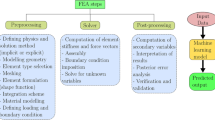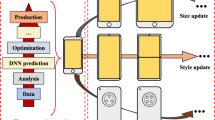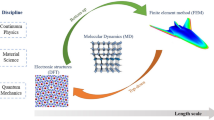Abstract
In scenarios where complex analyses are routinely conducted on similar structures, such as in a redesign process to meet performance requirements or when input parameters require frequent adjustments within a specified domain, a practical approach involves the use of metamodels calibrated using machine learning methodologies. In our investigation, we introduce a metamodel that utilizes an artificial neural network to analyze 3D nonlinear structures undergoing plastic deformations and large strains. Snap-through and snapback behaviors are addressed through network training, which is based on 10,000 Force vs Displacement curves (target outputs) obtained from nonlinear finite element analyses. This interplay between finite element analysis and machine learning, as demonstrated here, exhibits promising potential as an effective technique. The results indicate that the proposed deep neural network can learn from the simulations of finite elements. The discussion explores scenarios where the utilization of AI in the analysis of nonlinear structures is justified.






















Similar content being viewed by others

Data availability:
The authors confirm that the data supporting the findings of this study are available within the article and its supplementary materials.
References
Abdeljaber O, Avc O, Kiranyaz S et al (2017) Real-time vibration-based structural damage detection using one-dimensional convolutional neural networks. J Sound Vib 388:154–170
Abiodun OI, Jantan A, Omolara AE et al (2018) State-of-the-art in artificial neural network applications: a survey. Heliyon 4(11):e00,938
Abueidda DW, Koric S, Sobh NA (2020) Topology optimization of 2d structures with nonlinearities using deep learning. Comput Struct 237(106):283
Alves M (2020) Impact engineering: fundamentals, experiments and nonlinear finite elements, 1st edn. https://doi.org/10.4322/978-85-455210-0-6
Arnold F, King R (2021) State-space modeling for control based on physics-informed neural networks. Eng Appl Artif Intell 101(104):195
Arora R, Jacobson A, Langlois TR, et al (2018) Designing volumetric truss structures. arXiv:1810.00706v3
Bilal PM, Zaheer H et al (2020) Differential evolution: a review of more than two decades of research. Eng Appl Artif Intell 90(103):479
Chen D, Hu F, Nian G, et al (2020) Deep residual learning for nonlinear regression. Entropy 22(2)
Driemeier L, Proença SPB, Alves M (2005) A contribution to the numerical nonlinear analysis of three-dimensional truss systems considering large strains, damage and plasticity. Commun Nonlinear Sci Numer Simul 10:515–535
Esteva A, Kuprel B, Novoa RA et al (2017) Dermatologist-level classification of skin cancer with deep neural networks. Nature 542(7639):115–118
Gao T, Huang M, Wang Q et al (2018) A systematic model of stable multilateral automated negotiation in e-market environment. Eng Appl Artif Intell 74:134–145
Gu GX, Chen CT, Buehler MJ (2018) De novo composite design based on machine learning algorithm. Extreme Mechanics Letters 18:19–28
He K, Zhang X, Ren S, et al (2016) Deep residual learning for image recognition. In: 2016 IEEE Conference on Computer Vision and Pattern Recognition (CVPR), pp 770–778, https://doi.org/10.1109/CVPR.2016.90
Hencky H (2020) On the theory of plastic deformations and the residual stresses caused by them in the material. Journal of Applied Mathematics and Mechanics 100(3):e202002,019. https://doi.org/10.1002/zamm.202002019
Kingma DP, Ba J (2014) Adam: a method for stochastic optimization. CoRR arXiv:1412.6980 [cs.LG]
Koller L, Witteveen W, Pichler F et al (2021) A general hyper-reduction strategy for finite element structures with nonlinear surface loads based on the calculus of variations and stress modes. Comput Methods Appl Mech Eng 379(113):744
Lee S, Ha J, Zokhirova M et al (2018) Background information of deep learning for structural engineering. Archives of Computational Methods in Engineering 25(1):121–129
Li Y, Wang S, Han M (2019) Truss structure optimization based on improved chicken swarm optimization algorithm. Advances in Civil Engineering 2019
Liang L, Minliang L, Caitlin M, et al (2018) A deep learning approach to estimate stress distribution: a fast and accurate surrogate of finite-element analysis. J R Soc Interface 1520170844(15)
Liao X, Zheng X, He J et al (2021) Computer-aided decision-making system for endometrial atypical hyperplasia based on multi-modal and multi-instance deep convolution neural networks. Soft Comput. https://doi.org/10.1007/s00500-021-06576-6
Lukin N, Moura RT, Alves M et al (2020) Analysis of api s-135 steel drill pipe cutting process by blowout preventer. J Petrol Sci Eng 195(107):819. https://doi.org/10.1016/j.petrol.2020.107819
Ma N (2021) Analysis of industry convergence based on improved neural network. Soft Comput. https://doi.org/10.1007/s00500-021-06439-0
Ozbasaran H, Eryilmaz Yildirim M (2020) Truss-sizing optimization attempts with csa: a detailed evaluation. Soft Computing 24(22):16,775–16,801. https://doi.org/10.1007/s00500-020-04972-y
Rezaiee-Pajand M, Momenipour M, Hozhabrossadati SM (2020) A novel grey prediction evolution algorithm for multimodal multiobjective optimization. Engineering with Computers. https://doi.org/10.1007/s00366-020-01209-2
Russell SJ, Norvig P (2009) Artificial Intelligence: a modern approach, 3rd edn. Pearson
Shakya A, Nanakorn P, Petprakob W (2018) A ground-structure-based representation with an element-removal algorithm for truss topology optimization. Structural and Multidisciplinary Optimization 58
Shao Y, Liu CL (2020) Teaching machines to write like humans using l-attributed grammar. Eng Appl Artif Intell 90(103):489
Sharma O, Sahoo N, Puhan N (2021) Recent advances in motion and behavior planning techniques for software architecture of autonomous vehicles: A state-of-the-art survey. Eng Appl Artif Intell 101(104):211
Teng Z, Teng S, Zhang J et al (2020) Structural damage detection based on real-time vibration signal and convolutional neural network. Appl Sci 10:4720
Torky AA, Aburawwash AA (2018) A deep learning approach to automated structural engineering of prestressed members. International Journal of Structural and Civil Engineering 7(4):347–352
Vanluchene RD, Sun R (1990) Neural networks in structural engineering. Computer-Aided Civil and Infrastructure Engineering 5(3):207–215
Young T, Hazarika D, Poria S et al (2018) Recent trends in deep learning based natural language processing [review article]. IEEE Comput Intell Mag 13(3):55–75. https://doi.org/10.1109/MCI.2018.2840738
Zeng S, Hu Y, Xie X (2021) Q-rung orthopair fuzzy weighted induced logarithmic distance measures and their application in multiple attribute decision making. Eng Appl Artif Intell 100(104):167
Zhao H (2021) A reduced order model based on machine learning for numerical analysis: An application to geomechanics. Eng Appl Artif Intell 100(104):194
Zhou T, Hu Z, Zhou Q et al (2021) A novel grey prediction evolution algorithm for multimodal multiobjective optimization. Eng Appl Artif Intell 100(104):173
Acknowledgements
We thank prof. Thiago Martins, from Complex Systems Laboratory of University of São Paulo, for providing computer support.
Funding
The authors declare that no funds, grants, or other support were received during the preparation of this manuscript.
Author information
Authors and Affiliations
Corresponding author
Ethics declarations
Conflict of interest
Author Larissa Driemeier declares that she has no conflict of interest. Author Eduardo Lobo Lustosa Cabral declares that he has no conflict of interest. Author Gabriel Lopes Rodrigues declares that he has no conflict of interest. Author Marcos Tsuzuki declares that he has no conflict of interest. Author Marcilio Alves declares that he has no conflict of interest. Author Lucas Pires da Costa declares that he has no conflict of interest. Author Rafael Traldi Moura declares that he has no conflict of interest.
Ethical approval
This article does not contain any studies with human participants or animals performed by any of the authors.
Additional information
Publisher's Note
Springer Nature remains neutral with regard to jurisdictional claims in published maps and institutional affiliations.
Rights and permissions
Springer Nature or its licensor (e.g. a society or other partner) holds exclusive rights to this article under a publishing agreement with the author(s) or other rightsholder(s); author self-archiving of the accepted manuscript version of this article is solely governed by the terms of such publishing agreement and applicable law.
About this article
Cite this article
Driemeier, L., Cabral, E.L.L., Rodrigues, G.L. et al. On the use of AI for metamodeling: a case study of a 3D bar structure. Soft Comput (2023). https://doi.org/10.1007/s00500-023-09491-0
Accepted:
Published:
DOI: https://doi.org/10.1007/s00500-023-09491-0



